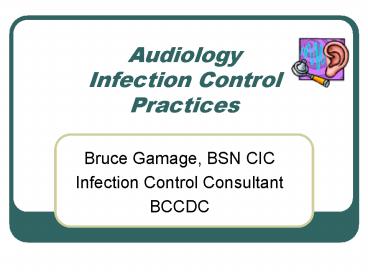Audiology Infection Control Practices - PowerPoint PPT Presentation
1 / 26
Title:
Audiology Infection Control Practices
Description:
Audiology. Infection Control Practices. Bruce Gamage, BSN CIC. Infection Control Consultant ... All treatment offered should minimize potential disease transmission ... – PowerPoint PPT presentation
Number of Views:99
Avg rating:3.0/5.0
Title: Audiology Infection Control Practices
1
AudiologyInfection Control Practices
- Bruce Gamage, BSN CIC
- Infection Control Consultant
- BCCDC
2
Outline
- Basic risk factors in patients
- Risk of cross-contamination
- Chain of Infection
- Spaulding classifications
- Scope of practice
- Routine
- High risk procedures
- Routine Practices
- Employee Health
- BBF exposure
3
Patient Risk Factors
- All treatment offered should minimize potential
disease transmission - Patients may have underlying disease
- May be immunosuppressed
- Drug related
- Leads to increase risk of infection from
opportunistic organisms
4
Chain of infection
Agent
Environment
Transmission
Host
5
Agent
- Infectiousness
- Pathogenicity
- Source
- Period of infectivity
- Portal of exit
6
Transmission
- Contact spread
- Common vehicle spread
- Airborne spread
- Vectorborne spread
7
Host
- Portal of entry
- Non specific defense mechanisms
- Skin, tears, mucous membranes, stomach acid,
inflammatory response - Specific Immunity
- Natural immunity, vaccinations
- Host response
8
Environment
- Dont over emphasize!
- Temperature
- Humidity
- Cleanliness
9
Risk of cross-contamination
- Patients and technicians
- Variety of contacts with environment and objects
- Direct or indirect contact with multiple patients
10
Spauldings Classifications
- Critical items
- Penetrate the skin, contact blood, unintact
mucous membranes require sterilization - E.g. curettes, wax loops, imittance and
autoacoustic emissions probe tips, ear impression
syringes and otoscopic specula - Many of these items are available as disposables
11
Spaulding's Classifications
- Semi-critical
- Contact intact mucous membranes - require
high-level disinfection - Non-critical
- Contact intact skin only - sterilization not
required - Require cleaning and disinfection
12
Cleaning
- Remove gross contamination
- Most important step to disinfection or
sterilization as soil will inhibit the process - Accomplished with brush, wipe or ultrasonic
machine
13
Disinfection
- Kills specific organisms depending on chemical
used - QAC, Phenolic will kill vegetative bacteria,
enveloped viruses (e.g. Hep B, C, HIV) - Aldehydes, Concentrated Hydrogen peroxide,
chlorine (bleach) will kill fungus, and enveloped
viruses dependent on contact time. Not bacterial
spores - Prolonged contact time can provide sterilization.
(must follow manufacturers recommendations for
concentration and contact time)
14
Disinfection
- Disinfection is acceptable for non-critical items
items that do not penetrate the skin, touch
mucous membranes - Noncritical items
- Earmolds,
- in the ear hearing aids
- Supra-aural headphones
- Otoscope specula
- Probe tips
- Electrodes
- All items should be cleaned and disinfected
between patients
15
Disinfecting the Environment
- Surfaces in work areas should be disinfected
regularly - Disinfectant wipes/squirt bottle
- Waiting room toys
- Your saliva is my saliva
16
Sterilization
- Kills all microbes, including spores
- Autoclaves
- Uses moist heat
- Must be used correctly
- Must be monitored
- Cold Sterilization
- Usually accomplished soaking in a chemical
sterilant (e.g. 2 gluteraldehyde, 7.5 hydrogen
peroxide) - Requires correct contact time and concentration
- Solutions should be monitored
17
Disposables
- Many items involved in cross-contamination are
available as disposables - Otoscope specula, probe tips, earmold impression
syringe tips, insert receivers, probe microphone
tubes. - May be cleaned and reused on same patient
- Re-use of disposables between patients
- Dont go there!
18
Scope of Practice
- Routine procedures
- More invasive procedures
- Exposure to body fluids
- Interoperative monitoring of cranial nerves
- Sensory evoked potentials
- Insertion needle electrodes
- Vestibular procedures (vomiting)
- Cerumen
19
Routine Practices
- Aimed at controlling exposure between people and
the environment/objects - Varies with the nature of the contact from simple
cleaning sterilization - Responsibility of Clinician to provide a safe
work environment for themselves, their colleagues
and their patients - Assume that every patient is potentially
infectious
20
Routine Practices
- Handwashing
- Soap
- Antibacterial soap
- Alcohol based hand rubs
- Equivalent to a handwash as long as hands are not
visibly soiled
21
Routine Practices
- Gloves
- Should be worn for all procedures where risk of
exposure to body fluids ( e.g. cerumen
management, draining ear, lesions present,
cleaning spills and disinfecting) - Single use
- Task specific
- Vinyl vs. Latex
- Utility Gloves for handling chemicals
22
Routine Practices
- Protective apparel
- Safety glasses and masks should be worn is risk
of splash or spatter of body fluids - Cerumen removal
- Working with grinding or buffing wheel
- Masks for potential TB patients
- Disposable headphone covers for mass screenings
23
Waste Disposal
- Waste that is contaminated with blood , body
fluids (ear drainage, cerumen) can go in regular
garbage unless dripping - Saturated materials, tissue, etc. must be placed
in biohazardous waste bags - Proper sharps disposal
- GVRD regulations require that biohazardous
waste/sharps must be picked up and processed
(either sterilization or incineration)
24
Employee Health
- Vaccinations
- Hepatitis B Vaccine
- MMR
- Diphtheria/tetanus (every 10 years)
- Influenza
- Varicella
- Hepatitis A? If working with high-risk population
25
BBF exposure
- Blood or other potentially infectious body fluids
- Intact skin
- No risk wash with warm soapy water
- Splash to mucous membrane or sharps injury
- High risk flush with NS, water
- Dont squeeze or soak in bleach
- Report to nearest emergency department for
- Assessment type of exposure/status of source
- Baseline blood work
- Possible ART
26
Summary
- Cross-contamination
- Cleaning, disinfection and sterilization
- Routine practices
Wash Your Hands































